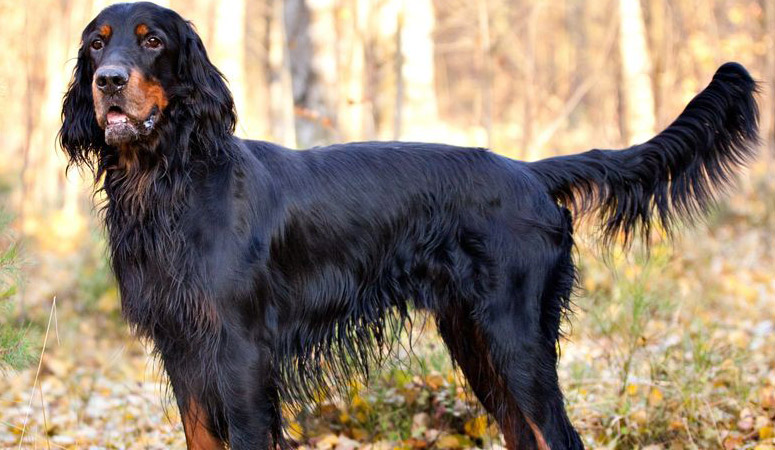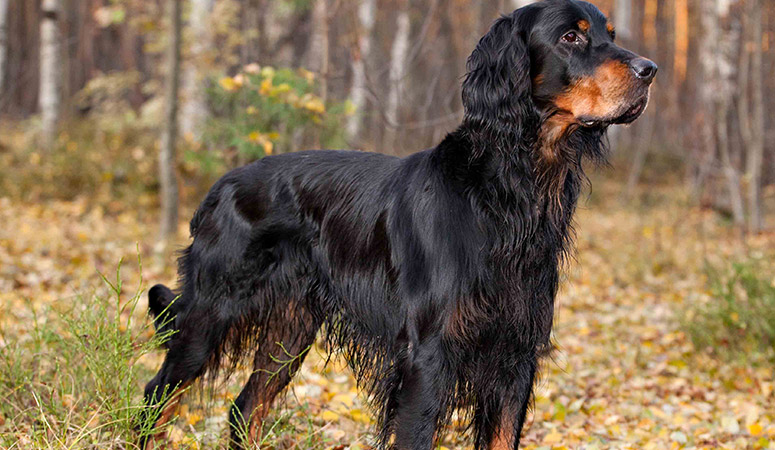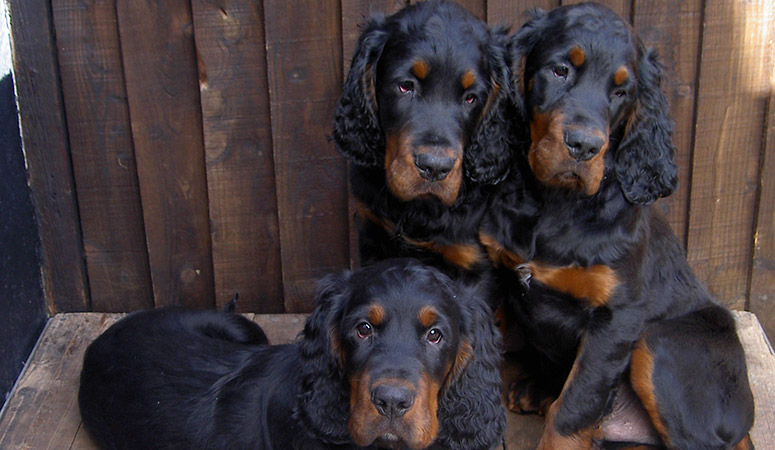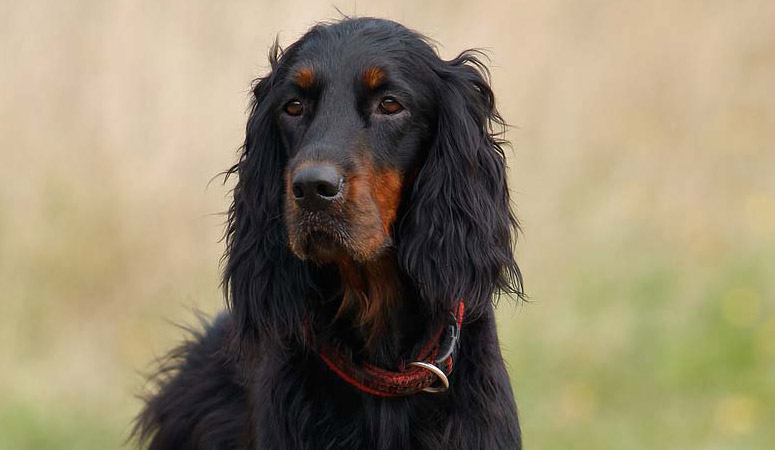Gordon Setter

The Gordon Setter is a large breed of dog, and was a member of the sporting group. They were originally developed from spaniel types to work alongside their owners as hunting dogs, now they are still great hunting companions. And Gordon Setters are very suitable to a family with an active lifestyle.
| Other Names | Setter Gordon |
| Color | Black & Tan, Red, Tan |
| Height | Males: 24-27 inches. Females: 23-26 inches. |
| Weight | Males: 55-80 pounds. Females: 45-70 pounds. |
| Life Span | 12-13 years |
| Personality | Affectionate, Confident, Bold |
| Exercise | Needs Lots of Activity |
| Origin |
| Popularity | #113 |
| Groom Needs | Weekly |
| Kids Friendly | Yes with supervision |
| Dog Friendly | Yes with supervision |
| Watch Dog | |
| Family Dog | Yes |
| Litter Size | 6-8 |
Gordon Setter Pictures
Gordon Setter Video
Introduction
The Gordon setter is focused and determined, used for hunting. They love their family, devoted their loved ones. There are 3 setter breeds of which the Gordon setter is the heaviest. He is actually quite a muscular dog and sturdy, with great stamina and strength, standing around 27 inches at the shoulders and weighing around 70 pounds. That means he needs plenty of exercises outdoors, keeping him in a fenced area so he doesn’t roam. He has a soft flat coat and distinctive colorings of black and tan – every now and then in this breed you might notice a white spot on his chest – it’s not unusual. His coat requires regular brushing. These dogs can adapt easily to different situations but being alone isn’t one of them or being crated for long periods of time. He’s smart, a bit stubborn, and averse to harsh discipline. Gordon Setters are good with children and other pets. They are considered not to be the best guard-dogs.
Living with Gordon Setter
Brush and comb your Gordon Setter two or three times every week to prevent mats and tangles, and regular brushing is helpful to minimize the shedding. Also, monthly grooming is recommended for your dog’s health, including trimming the hair on the bottom of his feet and between the toes, trimming inside and around ears, and trimming around tail area. Brushing will go a long way toward keeping your Gordon’s coat clean and shiny, but you can bathe him every one or two weeks if you want without drying out the coat.
As a dog who has the pendant or hanging ears is easy to have ear infections, the owner needs to check and clean the dog’s ears weekly with a gentle cleanser. And brush your dog’s teeth several times a week to keep fresh breath and prevent gum disease. Besides, trimming the nails regularly to prevent painful splitting, cracking, or broken nails.
Gordon Setters require strenuous exercise every day, so they are good companions for joggers or runners. It is important to give your dog a minimum of two hour’s exercise every day to prevent him from developing some unwanted behavioral issues which include being destructive around the house. There are good options for your dog to take exercise, such as dog sports, jogging, running off-leash in a securely, fenced yard. Given enough mental and physical exercise on a daily basis is helpful to keep your dog happy and healthy. Besides, the owner needs to know that never exercise the dog one-half hour before or one-half hour after feeding to prevent bloat.
Food high in protein (over 26 percent) is not recommended to feed the Gordon Setter, because this may cause health issues by forcing rapid growth. And fiber content of at least four percent is best to ensure firm stool. Generally, it is recommended to feed the Gordon Setter with two to three cups of high-quality dry dog food every day, divided into two meals. And there should be clean and fresh water at all times. More importantly, the food amount should depend on the dog’s weight, size, age, and activity level.
Some dogs are easy to get overweight, so you need to watch their calorie consumption and weight level all the time. Treats may be an important aid in training, but excessive intake can lead to obesity. Also, owners need to distinguish which human food is safe for dogs and which are not. If you have any problems with your dog’s weight or diet, just consult from your veterinarian.
Gordon Setters are prone to the following health conditions: hip and elbow dysplasia, epilepsy, progressive retinal atrophy, hypothyroidism, cerebellar abiotrophy, gastric torsion (bloat), cataracts, etc.
Major concerns: gastric torsion, CHD
Minor concerns: cerebellar abiotrophy, elbow dysplasia, hypothyroidism, PRA,
Suggested tests:
Elbow Evaluation
Hip Evaluation
PRA Optigen DNA Test
Ophthalmologist Evaluation
Total Annual Cost: $3239
Cost is estimated for the first year and may vary depending on many factors, such as dog food, health care, leash, collar, licensing, possible fencing, crates, training and obedience classes, dog-walking, grooming, treats, toys, flea, tick, and heart-worm meds, microchips, etc.
Gordon Setters are easy to train as they are intelligent dogs, but they need firmness and consistency to prevent them from taking advantage of you. They are usually people-pleasers, but sometimes can become stubborn and mischievous, so it is recommended to use positive reinforcement methods and with patience when training. Then they are able to learn basic obedience without much effort.
And early socialization and puppy training classes are important for Gordon puppies and help to ensure they grow into well-adjusted, well-mannered companions. Besides, Gordon Setter can burn their energy by participating in agility training and dog sports to get mental and physical stimulations. And they are happier and easier to manage when given much time to work and play.
History
The Gordon setter originated in Scotland way back in the 17th century. He was used as a sporting dog and became very popular in the 19th century when others noticed them – bred by the 4th Duke of Gordon. The dogs he bred were suited to the Scottish rough terrain where strength over speed was preferred. History has it that the Duke wouldn’t shoot around his Setters until they were 5 years old, as they were very playful and wild when they were young and slow to mature. When he died, his son carried on looking after the kennels and breeding the dogs. A dog from this kennel appeared in the first dog show in 1859 and the Setter won the first prize.
They were imported to the USA in 1842 by a man called George Blunt. He and Daniel Webster bought a breeding pair to the US and they started the Gordon Setter Club of America in 1924. The American Kennel Club added the breed in 1884.
In the first Stud Book of the Kennel Club, covering the years 1859-1874, there were 126 Black and Tans listed. Only in January 1924 did the Kennel Club accept the name of Gordon setter as a registered breed.
This dog has often been called a “one-man shooting dog”.
Some writings say “
They are not fast dogs, but they have good staying powers and can keep on steadily from morning until night”.
Helpful Information
Breed Club: GORDON SETTER CLUB OF AMERICA, INC.
Breed Club Link: https://www.gsca.org/
Breed Club Rescue:
Breed Club Rescue Link: https://www.gsca.org/index.php/rescue-contacts/




